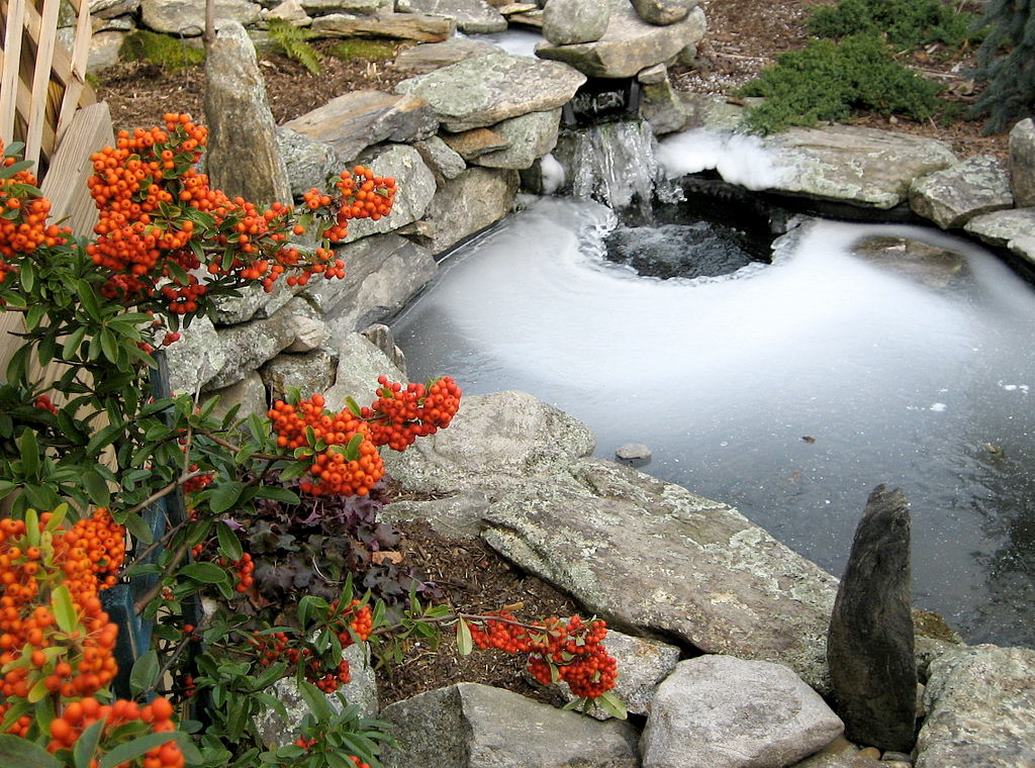Installing a pond is only the first step of a long journey.
Maintaining even a small pond in good condition requires dedication, background knowledge, and often spending some additional money.
One thing a pond-owner will surely need to do is prepare the pond for the season change. It may be delightful to admire flora and fauna grow during the summer; however, maintaining a pond through the winter requires some additional actions.
The factors that you should consider before getting down to securing the pond for the winter include the pond’s aesthetics, water chemistry, fish health, as well as others, such as weather conditions during winter in your area.

There are two things a pond-owner can do with his pond to make sure it retains its appeal after winter: shut it down or protect it by taking specific precautions. Choosing the correct solution depends strongly on the climate you live in.
Mild Climate
If you live in a place with temperatures varying from warm to mild in winter, most likely, you won’t have to deal with frozen water. However, your pond will still experience a few seasonal changes.
Here are some best ideas on how to prepare the lake for a mild winter.
First and foremost, make sure you cut back all the dead and dying foliage as the temperature drops. This way, you are keeping the pond clear of debris.
If you don’t make sure the falling leaves and debris are out of the pond, they can accumulate in the water, alter the water’s chemistry, and harm the fish. They are additionally creating perfect conditions for a spring algae bloom.
To avoid it, use a diffused aeration system to give your pond some air circulation and remove the leaves regularly. Moreover, use a topcoat pond net to prevent the leaves from falling into the water in the first place.
Cold Climate
You might be a pond owner who lives in states such as Tennessee or Idaho, where the winters are rather cold and snowy.
As the low temperatures start hitting your area, your pond’s water will most likely freeze, and you will need to decide whether to shut the lake down for the season or keep it open.
If you decide to keep it running, remember that the actions you will need to take are in addition to what was mentioned above.
The best practices of sustaining life in the pond during cold winter include:
Using a Pond De-icer
If you live in the area with cold temperatures all winter long, you might want to invest in the pond de-icer. The chances are that at least a flat surface of ice should appear on top of your pond.
If you keep fish under the surface, there must always be a hole at the surface of the water.
That way, you are allowing oxygen and sunlight in. Also, you are preventing toxic gases from accumulating under the water and harming the fish.
Keeping the Waterfall Surface Active
It is no secret that flowing water doesn’t freeze as quickly as the still water. Make sure there is always some water flow inside the pond. Moreover, watch for freezing at the edges of the water feature, which often triggers flooding and water loss.
Using a Pool Heater
That is a great way to ensure the right temperature for the fish to survive the cold winter. Avoid using copper radiators, as the element is toxic for koi.
Shutting the Pond Down
No matter the climate, you may decide to close the pond for the winter.
First and foremost, relocate the fish to warmer waters. Make sure you transfer them safely to their new home. Provide the fish with a container, where the water’s temperature would be similar to that in the lake.
Avoid placing them in much warmer water than what they are used to, or they might go into shock.
Take good care of the flora by moving the plants into pots before the first frost. Keep the plant’s roots wet by keeping the containers in shallow water. Put the flower pots in place with plenty of fresh air and sunlight.
Moreover, move the pond’s devices and equipment inside, and store it somewhere safe through the winter.
Conclusion
Although it is not the easiest task, it is possible to maintain the pond through the cold, windy, and snowy wintertime. The actions a pond owner should take depend strongly on the climate and temperatures throughout the winter.
People living in a mild climate in places such as Alabama or South Carolina may want to keep their ponds open. To do that, they should keep the falling leaves out of the lake and install an aeration system.
People living in the colder states with more snow may want to shut the ponds down for the winter. In such a case, they should pay special attention to their fish and plants and move them somewhere else, so they can start living in the pond again once the spring comes.









